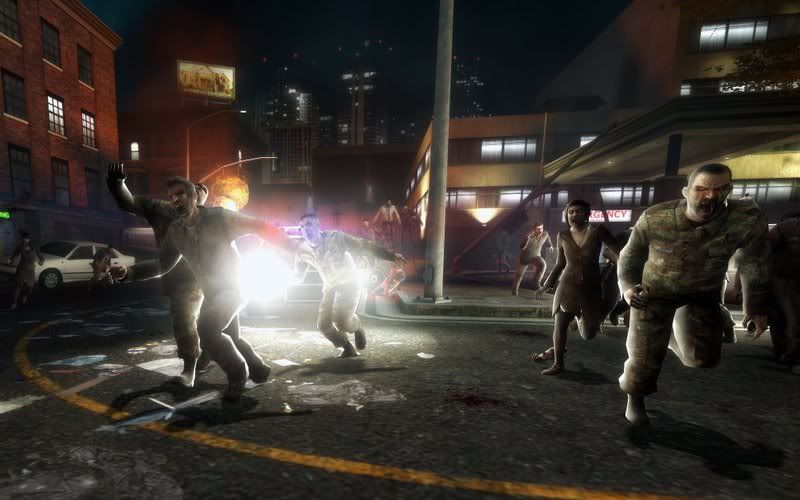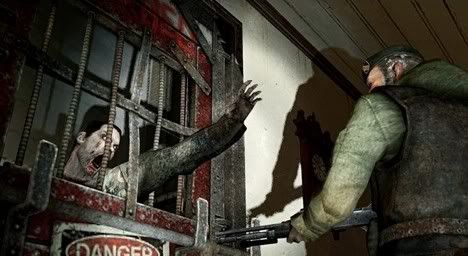Two minutes left before rescue. We -- four of us -- have been fighting off the relentless, Infected zombie hordes for over an hour and a half, sharing painkillers and first aid, lending a helping hand or providing cover fire. And now, with a rescue boat nearing the dock, it's about time to climb aboard and head to safety.
We're in good health, and in reasonably good spirits, so Left 4 Dead's AI Director (which controls the pacing of encounters) kicks in: There's no way we're getting off that easily. A gargantuan Tank arrives -- a bloodthirsty spire of muscle and rage -- with a swarm of screaming, ravenous zombies in tow. Standing tall and side by side, we open fire.
AI Director (which controls the pacing of encounters) kicks in: There's no way we're getting off that easily. A gargantuan Tank arrives -- a bloodthirsty spire of muscle and rage -- with a swarm of screaming, ravenous zombies in tow. Standing tall and side by side, we open fire.
Then, facing insurmountable odds and with panic dulling my senses, I do what any courageous, red-blooded gamer would do: I turn and bolt, making it to safety just in time to see one person pummeled into a lifeless pulp while the other two are pinned down, grappling with death's cold embrace.
It's a desperate ploy, but I know I only have to outrun the slowest member of our team. It's a sort of coerced teamwork -- one surviving member is all it takes to successfully complete a campaign, and I for one wasn't ready to be butchered yet again while helplessly firing off rounds at a never-ending swarm. To be honest, there's something beautiful about watching an efficient team with a well-rehearsed plan crumple under the weight of abject chaos.
Valve's Left 4 Dead is full of these little moments.
Plenty of games tout the cinematic experience, coupling melodramatic cut scenes with explosions, visceral combat and a story that's some variation on saving the world from Evil -- the standard Hollywood formula pressed onto a disc.
Valve's Left 4 Dead, on the other hand, takes the idea of interactive cinema and runs straight for the haunting, zombie-infested hills.
Please note: While it technically fits into the survival-horror genre, the game isn't remotely scary. Left 4 Dead's environments are dark and foreboding, and you might panic as a seemingly endless horde pours through the walls, but chances are you'll spend far more time cackling with glee at a timely escape (or crushing defeat). There's a comic, almost tacky, Day of the Dead sort of vibe, bolstered by the kitschy movie posters, graffiti-based arguments and conversations on the walls, and even the credits rolling at the end -- complete with "In Memoriams" for ... fallen teammates.
Left 4 Dead's environments are dark and foreboding, and you might panic as a seemingly endless horde po urs through the walls, but chances are you'll spend far more time cackling with glee at a timely escape (or crushing defeat). There's a comic, almost tacky, Day of the Dead sort of vibe, bolstered by the kitschy movie posters, graffiti-based arguments and conversations on the walls, and even the credits rolling at the end -- complete with "In Memoriams" for ... fallen teammates.
urs through the walls, but chances are you'll spend far more time cackling with glee at a timely escape (or crushing defeat). There's a comic, almost tacky, Day of the Dead sort of vibe, bolstered by the kitschy movie posters, graffiti-based arguments and conversations on the walls, and even the credits rolling at the end -- complete with "In Memoriams" for ... fallen teammates.
Nevertheless, you aren't playing a "movie," racking up kills as you move from cut scene to cut scene. Beyond a few snippets of background information on each character, there's no traditional narrative to be found, which is actually refreshing. We've all become fairly used to paging through dialogue trees and sitting through scripted sequences, so this might seem a little trite, but here goes: "Use your imagination."
The writing is on the walls: Who is Chicago Ted, whom no zombies are safe from? Did any of these people -- shuffling from safe room to safe room as we are -- make it out alive? The four Survivors you can choose from banter amongst themselves, cracking jokes to liven up the mood and even flirt, casually.
While I enjoyed piecing together their personalities based on how they reacted to my actions, I almost would've preferred some sort of bare-bones character creator, to really role-play a zombie apocalypse. Because interesting as the four Survivors are, the real story of the Campaign mode is about four players working together to cross the finish line, scooping up points and achievements along the way.
There aren't many scripts of any kind in Left 4 Dead. The game is divided into four Campaigns, with five maps each. While the maps are fairly linear and there are major set pieces -- a bridge to lower, a radio to respond to -- every element of the action is generated on the fly. The AI Director is Valve's answer to traditional spawn points, adjusting the pacing of the particular level based on how you're doing. Approach a barricaded building armed to the teeth with full health, and you can expect a gruesome experience. But if all four of your characters are limping along, the Director can be a bit merciful. While there are traditional difficulty settings, these only affect how much damage a Survivor can take before collapsing.
The end result is that you can repeat the same map countless times and get completely different experiences: Weapons aren't where they "should" be, power-ups appear in seemingly random places, a previously empty hallway becomes a hellish firefight. There are major events that remain the same -- always expect a Tank at a campaign's finale -- bu t for the most part you'll need to stay in constant communication with your partners, as it's hard to predict what will be around the next bend.
t for the most part you'll need to stay in constant communication with your partners, as it's hard to predict what will be around the next bend.
The game is ultimately about teamwork. Your fellow Survivors provide more than a few extra guns -- without them, you can be easily knocked onto the ground, or overwhelmed. As an added caveat, friendly fire is mandatory, so be ready to apologize for accidentally mowing down a comrade every now and then. There are a few safeguards: For starters, it takes quite a bit of damage to take a Survivor down, and once you are incapacitated, you can still fire your pistol at passers-by -- with unlimited ammo, just like in the movies!
But you will die, and sometimes you'll die often. While an entire team getting wiped out will simply have to start the map over again, if there's at least one Survivor, and a room with a closed door nearby, you might just hear someone clamoring for help. Yeah, it's kind of hard to feel bad for people when they're alive and well in a little while, but the occasional respawn point is literally a godsend with maps this long and brutal.
Versus mode takes the formula established by the campaign and adds four more players as the "Boss" Infected: mutated zombies with special abilities. The goals remain the same: Survivor players must escape, and Infected players must stop their progress. Versus mode felt in need of some serious balancing when I first attempted to compete. I was wrong.
I've played countless first-person shooters, and I can't honestly describe a situation where a skilled player couldn't simply abandon their comrades and at least score a few glory kills.
As the Infected, unless you've been randomly assigned to play as the Tank, you're rarely in any position to kill a Survivor. Instead, you've got to rely on the NPC zombie horde, using your own abilities to confuse your opponents, weakening them and forcing them to separate.
There are chinks in Lef t 4 Dead's armor. The single-player campaign is little more than a training ground, or perhaps an opportunity to snag some achievements you may have missed -- while NPC Survivors are skilled, they lack the ability to coordinate or plan, which sort of misses the point of the game altogether. For all intents and purposes, this is a strictly multiplayer experience.
t 4 Dead's armor. The single-player campaign is little more than a training ground, or perhaps an opportunity to snag some achievements you may have missed -- while NPC Survivors are skilled, they lack the ability to coordinate or plan, which sort of misses the point of the game altogether. For all intents and purposes, this is a strictly multiplayer experience.
If you enjoy playing first-person shooters with a team of friends or even complete strangers, Left 4 Dead offers an unparalleled social experience. It can be frustrating at times when the team's actions aren't synced, or strategies continually falter, but a bit of practice and, more importantly, communication will transform this zombie massacre into one of the most exciting and addictive gaming experiences ever. And once community members have the tools they need to make their tinkering easier, new layers of creativity and wonder will undoubtedly embellish an already impressive package.
Labels: Game Review

0 comments:
Post a Comment